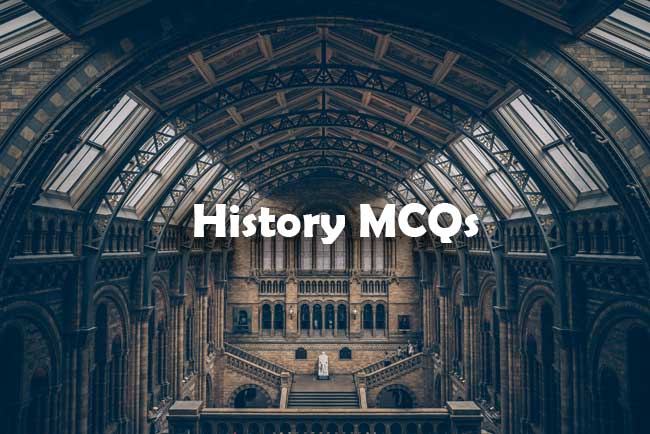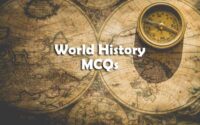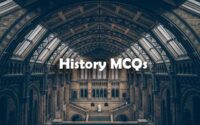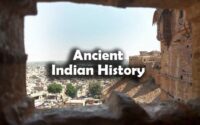MPSC History Questions and Answers
People who are in the search for MPSC History Questions and Answers Papers reached the safe place. This Page is the best source to get Maharashtra Public Service Commission History Old Question Papers. Here, you can find the free downloading links of the MPSC History Question Papers.

Therefore, start your preparation for the Maharashtra Public Service Commission History subject as much as possible. Applicants can also get the MPSC History Syllabus and Test Pattern along with Previous Question Papers. The MPSC History Syllabus is given here.
Along with MPSC History Solved Question Papers you can also check the MPSC History Answers Key. In this section, you can find the free download links of Maharashtra Public Service Commission History Exam Papers in Marathi.
MPSC History Previous Year Questions
1. Fire-altars found at the Harappan site of………………….bear special significance as being associated with community event.
(A) Kuntasi
(B) Kalibangan
(C) Surkotada
(D) Madina
2. Two most important Harappan crops were………………………….
(A) Wheat and Barley
(B) Sesame and Mustard
(C) Rice and Peas
(D) Cotton and Sugarcane
3. The following profession is not mentioned in Rig Vedic Samhita :
(A) Weaver
(B) Potter
(C) Goldsmith
(D) Ironsmith
4. The king of later Vedic times, whose rule extended from one ocean to another ocean, was called………………
(A) Raja
(B) Maharaja
(C) Ekrat
(D) Ekraj
5. The most famous ‘shatak’ of Mathura during post-Mauryan period was a type of…………………………..
(A) Metal
(B) Dance
(C) Wine
(D) Cloth
6. Which of the following writers ascertains that–During his father’s reign, Ashoka reduced a rising of the Nepalas and Khasyas, tribes of Himalayan mountaineers.
(A) Kautilya
(B) Bhasa
(C) Ashvaghosh
(D) Taranath
7. Which of the following the Girnar rock edicts of the Mauryan emperor Ashok mentions Kamboja, Gandhara and Aparanta ?
(A) First
(B) Fifth
(C) Eighth
(D) Tenth
8. Panini did not mention………………. as a type of gold coins in the Ashtadhyayi.
(A) Suvarna
(B) Nishka
(C) Suvarnamashaka
(D) Shataman
9. Karle cave complex was constructed by………………………..
(A) Gautamiputra Satakarni
(B) Nahapana
(C) Naganika
(D) Krishna III
10. The Buddhist art of Gandhara is exclusively well-known for……………….
(A) Absence of Buddha images
(B) Prevalence of depiction of the Buddha life scenes
(C) Absence of Bodhisattva images
(D) Only depiction of Jataka stories
11. Which of the following Gupta inscriptions is said to contain the most decisive evidence in favour of the exclusive ownership of land by the state ?
(A) Allahabad Prasasti
(B) Bhitari Prasasti
(C) Paharpur copper plate
(D) Junagarh Rock Inscription
12. Which of the following materials was not used in the Gandhara School of Art ?
(A) Grey Sandstone
(B) Terracotta
(C) Limestone
(D) Marble
13. The following is not a composition of Nagarjuna, the scholar who was a contemporary of the later Satavahanas :
(A) Yogachar
(B) Ratishastra
(C) Rasa-Ratnakar
(D) Setubandh
14. The coins of the………………….. dynasty depict the fish symbol on the reverse.
(A) Guptas
(B) Kushanas
(C) Hoyasalas
(D) Pandyas
15. Which of the following temples is not an example of the Pallava temple architecture ?
(A) Virattaneshvara Temple, Tiruttani
(B) Vaikunthaperumal Temple, Uttiramerur
(C) Kailasanatha Temple, Kanchipuram
(D) Koranganatha Temple, Srinivasanallur
16. Who among the following seems to have monopolized the trade in silk in ancient times ?
(A) Chinese
(B) Arabs
(C) Persians
(D) Sinhalese
17. Almost all classical schools of Indian philosophy believe in some form of doctrine of Karma except……………..
(A) Vedic
(B) Buddhist
(C) Jain
(D) Charvaka
18. Acharya Lakulisha is said to be the founder of…………………………..
(A) Vaishnavism
(B) Saivism
(C) Brahmanism
(D) Bhagvatism
19. Who called Harshavardhana ‘‘Sakal Uttarapatha Nath’’ ?
(A) Banabhatta
(B) Huien Tsang
(C) Dhruvasena II
(D) Pulakesin II
20. Which of the following ancient cities was never the capital of the Eastern branch of the Vakatakas ?
(A) Nandivardhan
(B) Pravarpur
(C) Padmapur
(D) Elichpur
|
More History Questions for Preparation
|
|
| UPSC | TNPSC |
| GPSC | WBCS |
| NDA | SSC CHSL |
| DSSB | SSC CGL |
| AFCAT | MTS |
| RRB NTPC | MPSC |
| MPPSC | CDS |
| BPSC | |
21. Which of the following Jain politicohistorian of tenth century composed Nitivakyamruta ?
(A) Bharavi
(B) Kalhana
(C) Somadeva
(D) Jayadeva
22. Which king’s Hyderabad Copper Plate gives information about the solar eclipse that occurred during third year of the king’s reign ?
(A) Pulakeshin II
(B) Krishna II
(C) Vikramaditya II
(D) Kattiyar
23. Which of the following writers has written extensively on the society of Rashtrakuta Empire ?
(A) Al-Masudi
(B) Ibn-Batuta
(C) Faris Shidyaq
(D) Abdur Razzak
24. Which of the following temples is not an example of the Badami Chalukyan temple architecture ?
(A) Sangameshvara Temple, Mahakuta
(B) Svarga Brahma Temple, Alampur
(C) Ladkhan Temple, Aihole
(D) Mahadev Temple, Ittagi
25. Matsyanyaya in early medieval Bengal meant…………………….
(A) Fisherman’s Court
(B) State of chaos
(C) Judge
(D) Fight for lakes of fish
26. Jinasena, the famous Jaina Scholar and author of Adipurana was at the court of…………………………………..
(A) Pala Ruler, Devapala
(B) Rashtrakuta Ruler, Amoghavarsha I
(C) Pratihara Ruler, Mihira Bhoja
(D) Solanki Ruler, Kumarapala
27. The Cholas evolved different structures of control by designating zones, in which ‘Kottam’ was…………..
(A) Urban space
(B) Rural space
(C) Hilly region
(D) Pastoral-cum-agricultural space
28. Nalayira-Divyaprabandham belonged to………………………..
(A) Tantrik Buddhism
(B) Tantrik Jainism
(C) Shaivism
(D) Vaishnavism
29. What was the gadyana ?
(A) A copper coin
(B) A gold coin
(C) Another name for a cowrie shell
(D) A silver coin
30. Within South India, warrior lineages approximate to the kshatriya model emerged only :
(A) In Kerala
(B) In Tamil Nadu
(C) In the Coromandel area
(D) In Andhra Pradesh
31. According to Harbans Mukhia, Indian familiarity with Persian at the popular level can be traced to the writings and discourses of………….
(A) Nasiruddin Chiragh
(B) Moin al-din Chishti
(C) Gesudaraz
(D) Baba Farid
32. Who introduced the ceremonies of sijda and paibos ?
(A) Iltutmish
(B) Balban
(C) Alauddin Khilji
(D) Muhammad bin Tughlaq
33. Where in the Deccan do we find the earliest Turkish styled hammams ?
(A) In Golconda, near Hyderabad
(B) In Firuzabad, near Gulbarga
(C) In Bijapur, near the Gol Gumbaz
(D) In Khuldabad, near Aurangabad
34. At the time of accession, Iltutmish was the governor of…………………..
(A) Bengal
(B) Sindh
(C) Multan
(D) Badaun
35. During Alauddin’s reign a Tanka was made of…………………………
(A) 50 Jitals
(B) 49 Jitals
(C) 48 Jitals
(D) 47 Jitals
36. The fort of Jajnagar, against which Ulugh Khan led an expedition, was in the kingdom of…………………….
(A) Odisha
(B) Malwa
(C) Gujarat
(D) Warangal
37. The ‘Bharuch hoard’ is an archaeological find of…………….. gold coins.
(A) 13th century
(B) 14th century
(C) 15th century
(D) 16th century
38. Prakurekhe is related to :
(A) Social system of Vijayanagar Empire
(B) Festivals of Vijayanagar Empire
(C) Law-codes of Vijayanagar Empire
(D) Revenue system of Vijayanagar Empire
39. One of the longest qanats in the Deccan is that which supplied water to the………………….fort.
(A) Golconda
(B) Gulbarga
(C) Bijapur
(D) Bidar
40. The Ni’matnama as a history of painting styles is important because it shows :
(A) The combination of Deccani and Rajput styles
(B) The emergence of a distinctive central Indian style
(C) The combination of Iranian and Indian styles
(D) The emergence of the Deccani style
| Ancient India | Modern India |
| Medieval India | World History |
41. At the Battle of Khanwa, Babar had to face……………………….
(A) Rana Sanga
(B) Rana Pratap
(C) The Afghans
(D) A confederacy of Rajputs
42. Which of the following Mughal rulers never established a permanent capital ?
(A) Babar
(B) Humayun
(C) Akbar
(D) Jahangir
43. Akbar abolished pilgrimage tax in…………….. and jizya in……………..
(A) 1563, 1564
(B) 1564, 1565
(C) 1543, 1544
(D) 1568, 1569
44. Name the monument built by Sher Shah in Delhi………………….
(A) Quwwatul Islam mosque
(B) Qila-i-Kuhna masjid
(C) Siri fort
(D) Hauz Khas madrasa
45. Which of the following is an important source for the study of the Nizamshahi dynasty and Malik Ambar ?
(A) Ain-i-Akbari
(B) Futuhat-i-Salatin
(C) Burhan-i-Maasir
(D) Tuzuk-i-Babari
46. Which of the following were the main Nayak kingdoms that emerged after the decline of the Vijayanagar Empire ?
(A) Madurai, Jinji, Thanjavur
(B) Jinji, Mysore, Madurai, Thanjavur
(C) Madurai, Jinji, Thanjavur, Mysore
(D) Madurai, Jinji, Thanjavur, Ikkeri
47. The Char Minar at Daulatabad was erected by Zafar Khan who is better known as :
(A) Alauddin Hasan Bahman Shah
(B) Firoz Shah Tughlaq
(C) Firoz Bahman Shah
(D) Ulugh Khan
48. The Marathas attacked Goa in :
(A) 1677
(B) 1689
(C) 1730
(D) 1756
49. In the Vijayanagar Empire’s administrative system, to what do the terms amara, bhandarvada and manya refer ?
(A) Types of land grants
(B) Types of taxes
(C) Modes of transport
(D) Customs duties collected at the port of Krishnapattam
50. Khurda was a form of payment……….. made to……………..
(A) In kind, the Kulkarni
(B) In kind, the Patil
(C) In cash, the Kulkarni
(D) In cash, the Patil



